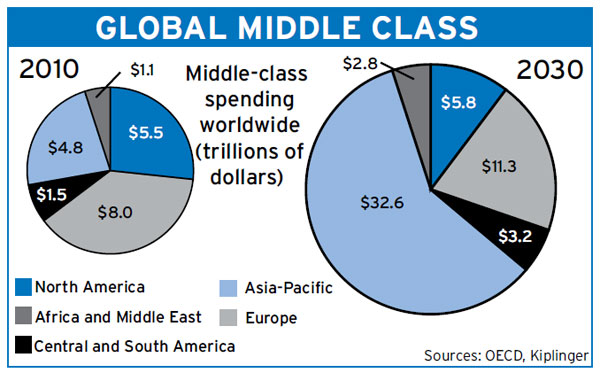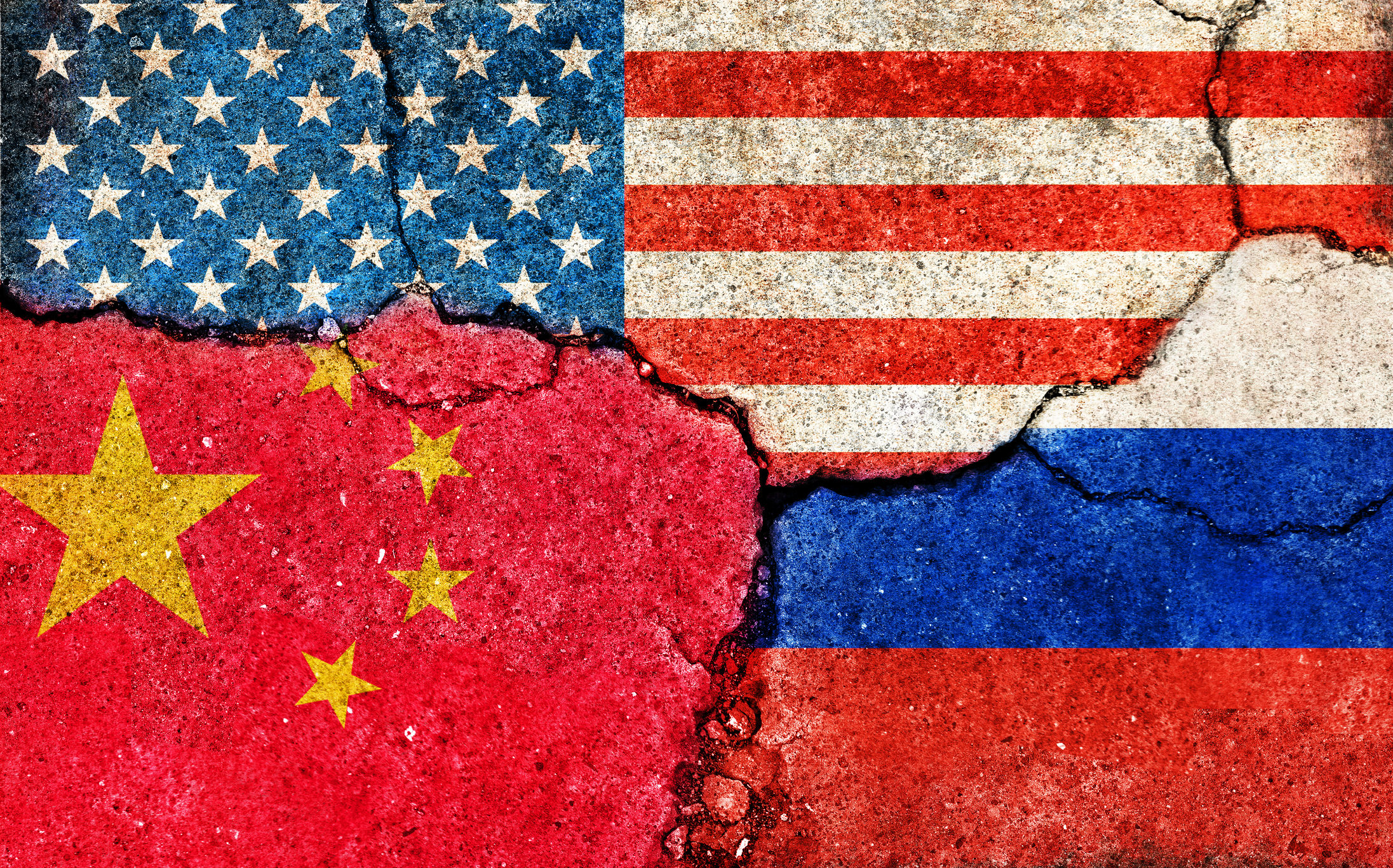Middle-Class Spenders Will Lead Global Growth
Wealthier overseas consumers spell opportunity for American vendors who can take advantage.

Here's one reason to be optimistic about the long-term potential of the global economy: the emergence of a global middle class. About 1.8 billion strong now, the global middle class will number close to 5 billion consumers by 2030, according to estimates from the Organization for Economic Cooperation and Development. Broadly defined as consumers with enough income for food, clothing and shelter basics plus discretionary purchases, this group will spend about $56 trillion a year come 2030, nearly three times as much as they shell out today. These consumers will insist on a higher standard of living, with meatier diets, bigger houses and better hygiene. And they'll clamor for a wide range of consumer goods -- from air conditioners and electronics to cosmetics and organic foods.
Opportunities abound not just for consumer goods, but also for providing services for the growing middle class abroad. Insurance, consulting, financial, medical, engineering and architectural services will be in demand as the quality of life increases. That'll be a boon for U.S. businesses. Services already make up about 30% of U.S. exports and the share will continue to increase in coming years. Growth of the middle class in emerging economies around the world will also give a big boost to U.S. tourism and foreign demand for an American education. International travel by the Chinese alone will grow 17% a year over the next decade. U.S. hotel chains, such as Starwood, Hilton and Marriott, intend to take full advantage of the trend, putting in place programs to reach the growing number of Asian tourists.
For many U.S. businesses, recognizing and acting on this demographic trend will be critical, as long-term economic growth in the mature domestic market flattens out. Americans currently account for 12% of the middle-class population and about one-fifth of its spending. By 2030, U.S. consumers will be just 4% of the middle class worldwide and account for 8% of its spending. Meanwhile, Asia's middle class will explode to make up 66% of the group worldwide and claim 59% of middle-class purchases in 2030. Moreover, despite this year's uninspiring 3.4% gain for the world economy, the pace of gains in Asian, Latin American and African economies still outpace that of the U.S. and most of Europe, now suffering through a recession.

Sign up for Kiplinger’s Free E-Newsletters
Profit and prosper with the best of expert advice on investing, taxes, retirement, personal finance and more - straight to your e-mail.
Profit and prosper with the best of expert advice - straight to your e-mail.
The shift in the world market spells challenges, too, of course. Reaching customers in different cultures typically requires different strategies, marketing, and in some cases, even different packaging and ingredients. The selection of Kraft's Nabisco Oreos, for example, varies widely by market. There are green tea Oreos in China, a chocolate and peanut variety in Indonesia, and banana and dulce de leche Oreos in Argentina. The company's ability and willingness to adapt its products to local market preferences have helped Nabisco grow the Oreo brand abroad. Emerging markets will account for about half of Oreo sales this year.
Companies will also have to find ways to cut the costs and prices of products made for the U.S. and other developed nations. What's middle class in the U.S. is far above what is middle class in Asia or Africa. In emerging markets, the percentage of truly discretionary income is dramatically lower. In China and India, for example, about 40% of average household income is spent on food and transportation, compared with 25% in the U.S. So much of what is offered elsewhere may be lower-end products than those sold here. When beer manufacturer SABMiller, for example, found it couldn't economically sell its standard barley-based beer to Africa's new middle-class consumers, the company retooled its factories to use cheaper, locally sourced ingredients, such as cassava, to produce a beer at a price African consumers could afford.

The race to reach this mass of new middle-class customers is already under way. American companies have the advantage of brand names known worldwide, but local manufacturers often have a logistical edge. In China, India and elsewhere, they're battling for turf. Chinese beverage maker Hangzhou Wahaha became a $5.2-billion company in trying to stave off Coca-Cola and Pepsi. It benefited from increased consumer demand for soft drinks. Nevertheless, Coca-Cola will double its volume by 2020 with increased sales in emerging markets.
Transitioning to a global market isn't easy. Brand building and customer loyalty takes time. Home Depot, for one, shuttered five of its initial 10 stores in China as it searched for its niche in the marketplace. But a global reach will pay off for most companies as middle-class spending in emerging markets continues its meteoric rise.
Get Kiplinger Today newsletter — free
Profit and prosper with the best of Kiplinger's advice on investing, taxes, retirement, personal finance and much more. Delivered daily. Enter your email in the box and click Sign Me Up.

-
 Planning for Health Care Costs in Retirement: A Comprehensive Guide
Planning for Health Care Costs in Retirement: A Comprehensive GuideMedical expenses aren't slowing down, and if you're not prepared, they can hit you like a ton of bricks.
By Bob Chitrathorn
-
 When Should You Hand Over the Keys — to Your Investments?
When Should You Hand Over the Keys — to Your Investments?The secret to retirement planning? "The best time to hand over the keys is before you’ve realized you need to hand over the keys."
By Maurie Backman
-
 The Economic Impact of the US-China Trade War
The Economic Impact of the US-China Trade WarThe Letter The US-China trade war will impact US consumers and business. The decoupling process could be messy.
By David Payne
-
 AI Heads to Washington
AI Heads to WashingtonThe Kiplinger Letter There’s big opportunity for AI tools that analyze MRIs and other medical images. But also big challenges that clinicians and companies will have to overcome.
By John Miley
-
 The AI Doctor Coming to Read Your Test Results
The AI Doctor Coming to Read Your Test ResultsThe Kiplinger Letter There’s big opportunity for AI tools that analyze CAT scans, MRIs and other medical images. But there are also big challenges that human clinicians and tech companies will have to overcome.
By John Miley
-
 The New Space Age Takes Off
The New Space Age Takes OffThe Kiplinger Letter From fast broadband to SOS texting, space has never been more embedded in peoples’ lives. The future is even more exciting for rockets, satellites and emerging space tech.
By John Miley
-
 Rising AI Demand Stokes Undersea Investments
Rising AI Demand Stokes Undersea InvestmentsThe Kiplinger Letter As demand soars for AI, there’s a need to transport huge amounts of data across oceans. Tech giants have big plans for new submarine cables, including the longest ever.
By John Miley
-
 What DOGE is Doing Now
What DOGE is Doing NowThe Kiplinger Letter As Musk's DOGE pursues its ambitious agenda, uncertainty and legal challenges are mounting — causing frustration for Trump.
By Matthew Housiaux
-
 A Move Away From Free Trade
A Move Away From Free TradeThe Letter President Trump says long-term gain will be worth short-term pain, but the pain could be significant this year.
By David Payne
-
 Trump’s Whirlwind Month of Crypto Moves
Trump’s Whirlwind Month of Crypto MovesThe Kiplinger Letter The Trump administration wants to strengthen U.S. leadership in the cryptocurrency industry by providing regulatory clarity.
By Rodrigo Sermeño